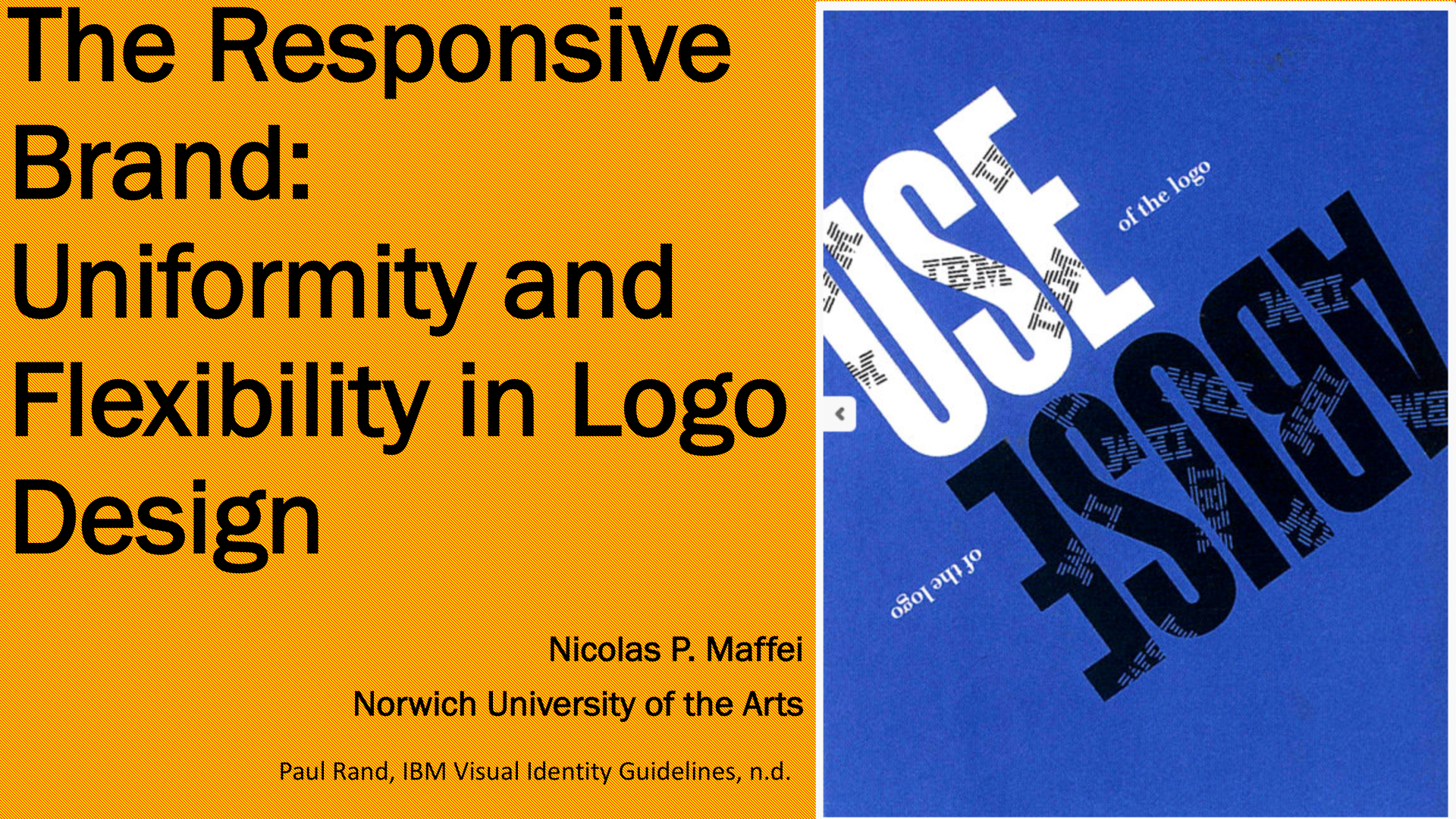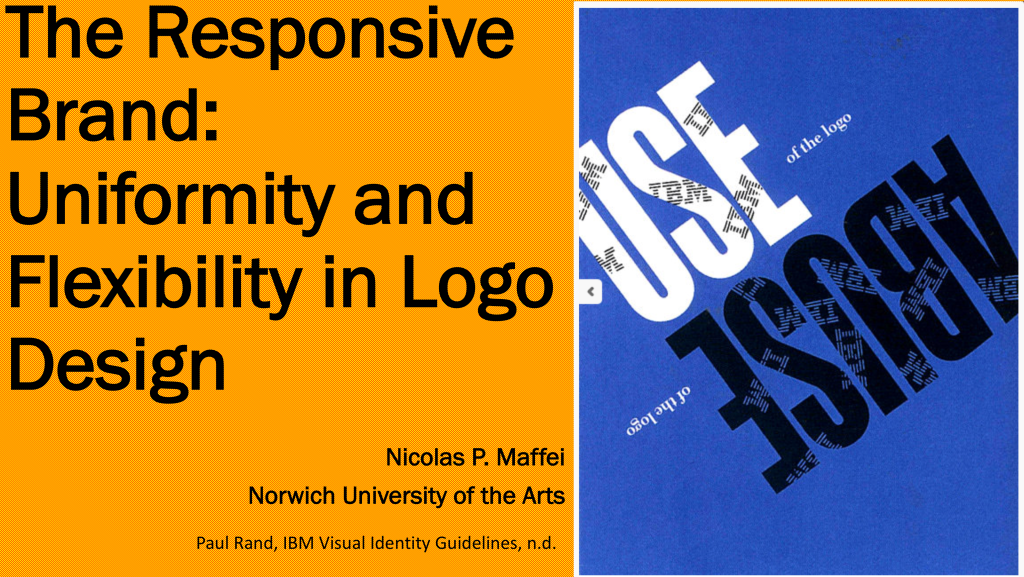The Responsive Brand: Uniformity and Flexibility in Logo Design
A talk presented to the Theorising Visual Art and Design (TVAD) research group, University of Hertfordshire, by Dr Nicolas P. Maffei (Norwich University of the Arts) Wednesday May 10th 2017 https://www.youtube.com/watch?v=BtIKBfqFiyg and to the Pattern and Chaos research group, NUA. Monday May 15th 2017.
From the uniformity of modernism to the embrace of difference, this talk explores the historical shift from static to dynamic logos, from universal international brand identities to more flexible and responsive corporate personalities. This transformation occurred over a period extending from the nineteenth century to the present, and includes the roots of branding, the ideals of modernism, the emergence of the critical consumer, the development of the responsive corporation, and the co-creation of brands in online landscapes. From Peter Behrens’ designs for the German Allgemeine Elektrizitäts-Gesellschaft (AEG), in 1907, considered the first corporate identity, to Paul Rand’s flexible and humanizing identity developed for International Business Machines Corporation (IBM) after WWII, this talk reviews the rise of the unchanging logo and, in turn, the multivalent brand-mark.

In addition, the design responses of corporations to the vocal and ethically informed consumer are surveyed via the anti-branding movement, which has targeted Starbucks and McDonalds among other corporations.

Nike is examined through local reinterpretations of the global brand. Gap’s failed logo of 2010 shows the power of the online consumer and the need for companies to listen and respond.

Finally, brand reactions to the responsive consumer – characterized by chameleon-like logo transformation and an emphasis on user interaction and co-production of meaning, are investigated through the designs for telecommunications company Ollo (Bibliothèque, 2012), the identity for the Tate museums (Wolff Olins, 1999), and Experimental Jetset’s Responsive ‘W’ for The Whitney Museum (2011).

All images above are used for the purposes of education, comment, critique and are non-profit.
References
Anderson, Benedict. 1991 [1983]. Imagined Communities: Reflections on the Origin and Spread of Nationalism. Revised edition. London: Verso.
Arvidsson, Adam. 2006. Brands: Meaning and Value in Media Culture. London and New York: Routledge.
Asmussen, Bjoern, Sally Harridge-March, Nicoletta Occhiocupo, and Jillian Farquhar. 2013. ‘The Multi-layered Nature of the Internet-based Democratization of Brand Management’. Journal of Business Research, no. 66: 1473-1483.
Baudrillard, Jean. 1998. The Consumer Society: Myths and Structures. Newbury Park, CA: Sage.
Bauman, Zygmunt. 2004. Identity: Conversations with Benedetto Vecchi, Cambridge: Polity.
Bick, Paul B. and Sorina Chiper. 2007. ‘Swoosh Identity: Recontextualizations in Haiti and Romania’, Visual Communication 6, no. 1: 5-18.
Bruce, Gordon 2006. Eliot Noyes: A Pioneer of Design and Architecture in the Age of American Modernism. London: Phaidon.
Campbell-Dollaghan, Kelsey. 2013. ‘The Age of the Anti-Logo: Why Museums Are Shedding Their Identities’, Gizmodo, 3 June. http://gizmodo.com/the-age-of-the-anti-logo-why-museums-are-shedding-thei-510739591 Accessed 27 April, 2015.
Elliot, Stuart. 2010. ‘Gap Inc. Puts ‘GAP’ Back in Logo’, New York Times, 12 October, 2.21pm, http://mediadecoder.blogs.nytimes.com/2010/10/12/gap-inc-puts-gap-back-in-logo/?_r=0 Accessed 13 May, 2015.
Firat, A. F., and A. Venkatesh. 1995. ‘Liberatory Postmodernism and the Reenchantment of Consumption’, Journal of Consumer Research 22, no. 3: 239-267.
Frampton, Jez. 2012. ‘Branding in the Post Digital World’. Lecture abstract. 31 October. http://www.ie.edu/alumni/lifelong-learning/agenda/clubs/functional/882b31367688a310VgnVCM1000004b01050aRCRD?_adptlocale=en_US Accessed April 27th, 2015.
Goldman, Robert and Stephen Papson. 1998. Nike Culture: The Sign of the Swoosh. London: Sage.
Habermas, Jürgen. 1985. The Theory of Communicative Action. Boston: Beacon.
Harwood, John. 2011. The Interface: IBM and the Transformation of Corporate Design, 1945-1976. Minneapolis and London: University of Minnesota Press.
Hebdige, Dick. 1979 (2003 reprint). Subculture: The Meaning of Style. London and New York: Routledge.
Heller, Steven. 1999. Paul Rand. London: Phaidon Press.
Henrion, F.H.K. and Alan Parker. 1967. Design Coordination and Public Image. London: Studio Vista.
Kamekura, Y. 1966. Trademarks and Symbols of the World. London: Studio Vista.
Holt, Douglas B. 2002. ‘Why Do Brands Cause Trouble? A Dialectical Theory of Consumer Culture and Branding’. Journal of Consumer Research, 29, no. 1: 70-90.
Lees-Maffei, Grace and Rebecca Houze, eds. 2010. The Design History Reader. Oxford and New York: Berg.
Levi-Strauss, Claude. 1966. The Savage Mind. London: Weidenfield and Nicolson.
Moor, Liz. 2007. The Rise of Brands. Oxford: Berg, 2007.
Olins, Wally. 2014. Brand New: The Shape of Brands To Come. London: Thames and Hudson.
Pongsakornrungsilp, Siwarit, and Jonathan E. Schroeder. 2011. ‘Understanding Value Co-creation in a Co-consuming Brand Community’, Marketing Theory, 11, no. 3: 303-324.
Prahalad, C.K. and Venkat Ramaswamy. 2004. ‘Co-Creation Experiences: The Next Practice in Value Creation’. Journal of Interactive Marketing, 18, no. 3: 5-14.
Rand, Paul 1955. ‘IBM Presentation…1955’, ACCN 1745/200-M-133, Box 22, Folder ‘IBM 1962-66 (1 of 2),’ Paul Rand Collection, Yale University Archives.
Rand, Paul and IBM Corporate Brand Management. 1994. The Spirit and the Letter. Armonk, N.Y.: IBM.
Rhizome. 2001. ‘The World’s First Generative Logo?. http://rhizome.org/editorial/2001/sep/5/the-worlds-first-generative-logo/ Accessed May 1st 2015
Rumbo, Joseph D. 2002. ‘World of Advertising Clutter: The Case of Adbusters’, Psychology and Marketing, 19, no. 2: 127-148.
Scheffler, Karl. 1908. ‘Kunst und Industrie’, Kunst und Künstler, 6, no. 10: 343 (trans. Frederick J. Schwartz).
Schwartz, Frederick, J. 1996. ‘Commoditiy Signs: Peter Behrens, the AEG, and the Trademark’, Journal of Design History, 9, no. 3: 153-184.
Scissons, M., M. Kalehoff, and R. Laufer. 2013. The Value of a Facebook Fan 2013: Revisiting Consumer Brand Currency in Social Media. New York: Syncapse.com.
Wang, Yichuan and M. Nick Hajli. 2014. ‘Co-creation in Branding through Social Commerce: The Role of Social Support, Relationship Quality and Privacy Concerns’. In Proceedings of the Twentieth Americas Conference on Information Systems, 1-16. Savannah: Georgia.
Williams, Eliza. 2011. ‘Branding the Art World’. Creative Review, October. http://www.creativereview.co.uk/back-issues/creative-review/2011/october/branding-the-art-world Accessed May 20th 2015.
Wood, Timothy. 2015. ‘Brand to the Future: How is the Future of Branding Adapting to Changing Technology’. BA Thesis. Norwich University of the Arts, Norwich.

